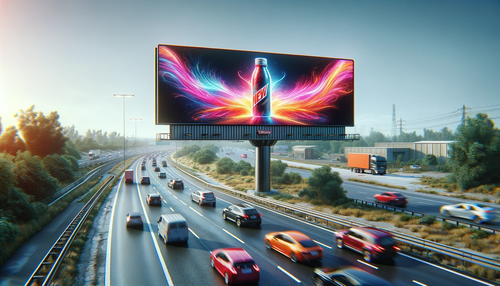What is a Bulletin Billboard?
Bulletin billboards are a staple in outdoor advertising, serving as powerful tools to capture attention and communicate messages to a broad audience. Positioned predominantly in high traffic areas, such as major roads and busy city intersections, these large-format advertisements are designed to be eye-catching and impactful. This article delves into the details of bulletin billboards, their sizes, media formats, and their role in the advertising landscape.
Defining Bulletin Billboards
A bulletin billboard is a large outdoor advertising structure that typically measures 14 feet high by 48 feet wide, though sizes vary. Due to their prominent placement and substantial size, bulletin billboards are known for their ability to attract the attention of drivers and pedestrians from significant distances. They are the most dominant and impactful type of billboard, used for major brand advertising campaigns.
Sizes and Specifications
Bulletin billboards come in various sizes, but the standard size is 14 feet by 48 feet, providing 672 square feet of advertising space. This size allows for creative freedom, enabling advertisers to use bold images, large text, and innovative design elements to ensure their message stands out. Other common sizes include 10.5 feet by 36 feet and 20 feet by 60 feet, depending on the location and visibility requirements.
Media Formats
Bulletin billboards can be either static or digital.
Static Bulletin Billboards: These are traditional billboards with printed vinyl or painted advertisements. They are cost-effective and can stay in place for extended periods, making them suitable for long-term campaigns. The artwork is printed on durable vinyl and stretched over the billboard frame, ensuring it withstands various weather conditions.
Digital Bulletin Billboards: Digital billboards are increasingly popular due to their flexibility and dynamic capabilities. These billboards use LED technology to display digital ads that can change every few seconds. They offer several advantages, including displaying multiple ads in a single location, real-time updates, and interactive features such as countdowns or social media feeds. Digital billboards are especially effective in high traffic areas where they can engage audiences with changing content.

Locations and Effectiveness
Bulletin billboards are strategically placed in high-traffic areas such as major highways, city centers, and busy intersections. Their locations are chosen to maximize visibility and reach a broad audience. High-traffic areas ensure that a large number of people see the advertisement multiple times, increasing brand recall and effectiveness.
Billboard advertising, particularly bulletin billboards, is a form of out-of-home (OOH) advertising that remains effective despite the rise of digital media. According to a report by BrandXR, the effectiveness of bulletin billboards is rooted in their ability to deliver high-impact visual messages that are difficult to ignore. This form of advertising is particularly effective for brand awareness campaigns, where the goal is to make a lasting impression on a large audience.
Advantages of Bulletin Billboards
- High Visibility: Due to their large size and strategic placement, bulletin billboards can capture the attention of drivers and pedestrians from a distance.
- Broad Reach: Positioned in high traffic areas, these billboards reach a diverse audience, making them ideal for mass-market advertising.
- Creative Freedom: The large advertising space allows for creative and impactful designs that can enhance brand messaging.
- Long-Term Exposure: Static billboards provide continuous exposure, ensuring the ad is seen repeatedly by the same audience, reinforcing the message.
- Dynamic Content: Digital bulletin billboards allow users to change content frequently, keeping the advertisement fresh and engaging.
Case Studies and Examples
Many brands have leveraged bulletin billboards to create memorable advertising campaigns. For instance, companies like Coca-Cola, McDonald's, and Nike have used these billboards to launch major marketing initiatives, taking advantage of the high visibility and broad reach. These campaigns often incorporate bold visuals and clear messaging to maximize impact.
In addition, digital bulletin billboards have been used effectively for time-sensitive promotions and events. For example, a digital billboard might display different ads at different times of the day, promoting breakfast deals in the morning and dinner specials in the evening.
Challenges and Considerations
While bulletin billboards offer numerous advantages, there are also challenges to consider. The cost of leasing high-traffic billboard space can be significant, and the production and installation of large-format ads require careful planning and investment. Additionally, digital billboards may face regulatory restrictions in certain areas, limiting deployment.
However, despite these challenges, bulletin billboards remain a powerful advertising tool. Their ability to deliver high-impact messages to a broad audience makes them valuable to any integrated marketing strategy.
Conclusion
Bulletin billboards are a cornerstone of outdoor advertising, offering unmatched visibility and reach in high traffic areas. Whether static or digital, these large-format advertisements are designed to capture attention and leave a lasting impression. As advertising continues to evolve, bulletin billboards remain vital for brands looking to enhance their visibility and connect with a broad audience.
TALK TO A PRO
We're here to bring your brand to life!
Stay Connected with BrandXR
Create Augmented Reality for Free!
Create, Publish, and Measure 3D Augmented Reality Experiences Without Having to Code.














